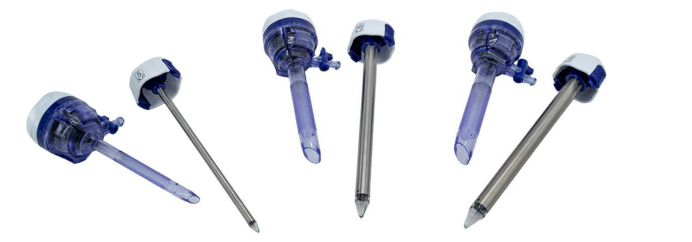INSERTION OF THE TROCAR
Aug 08, 2024Trocar is used in gynecologic and abdominal endoscopic procedures for establishment of a port of entry for instrumentation.

Trocar insertion is the first issue when choosing a laparoscopic surgical approach, which is completely different from the incision selection for open surgery.
The incision selection for open surgery follows the shortest distance principle, and the incision closest to the operating site is selected;
In laparoscopic surgery, due to the need for sufficient distance to focus and the slender size of surgical instruments, it is necessary to maintain a certain distance from the surgical site.
Around the surgical site, make incision holes with size 0.2~1.5cm. Although it is as parallel to the skin lines as possible, there is no requirement for the size of the incision hole and there is no need to follow the shortest distance principle.
The following are several insertion methods:
1.Concentric circles rule
That is, take the lesion or surgical operation site as the center of the circle, select a certain distance (different for various surgical procedures, usually >10cm) as the radius to make one or more arcs, and intercept several points on the arcs as the placement points of the trocar , and the observation window is mostly the center of the arc.
If you select points on different arcs, you should avoid selecting two points on the same radius or a similar radius, otherwise "coaxial interference" will occur, that is, the instrument blocks the lens (coaxial with the observation) or the hands interact with each other when operating forward and backward. interference.
There must be a certain "lateral spacing" between trocars to avoid the "chopstick effect". Generally, the "shortest spacing" is more than 5cm.
2.slope effect
It means that there is a bulge of tissue between the surgical operation site and the lens, which affects the exposure of the dorsal side. For example, the bulging pancreas during radical gastrectomy will affect the exposure of No. 7, 8, and 9 lymph nodes.
In order to avoid the "slope effect", a position closer to the upper edge of the lesion should be selected as the observation window when insert the trocar. For example, in stomach surgery
, it is easier to observe the lymph nodes at the upper edge of the pancreas by selecting a puncture hole above the umbilicus than below the umbilicus.
However, it is also important to avoid placing the observation window "directly above" the lesion. The perspective directly above is similar to a satellite map image, and can not see the side details and three-dimensionality.
Therefore, the corresponding observation angle should be selected based on laparoscopes with different angles (current laparoscope product angles are 10~45°). For the most commonly used 30° angle, it is recommended to choose an observation angle of 30~45°.
3. Mirror pivot principle
That is, the laparoscope, target, and monitor form the central axis of the entire operation. The personnel positions and trocar holes should be designed and implemented around this central axis to facilitate the surgical operation.
4. Triangle rule
The operating holes of the laparoscope and the operator's left and right hands should be distributed as much as possible into an inverted equilateral triangle. Other auxiliary operating holes should be flexibly arranged around this core triangle according to surgical needs. This rule is similar to the principle of the "concentric circle rule" mentioned above.
5.Angle 60 rule
That is, the closer the intersection angle of the operator's left and right hand instruments is to 60° when operating together within the target, the more ergonomic the principle will be and the operation will be smoother and more convenient.
6.Three points and one line rule
That is, the two operating instruments are located on the same side of the observation laparoscope and in a straight line with their positions.
When the patient is lying on his side, when some operations need to be directed toward the patient's head or feet, the surgeon has to lean in or excessively abduct one side of the upper arm to operate. The operation takes a long time and may lead to fatigue. Using this method, the surgeon can maintain a comfortable position for the operation.
7.conducive to subsequent operations rule
The course and location of the incision sometimes need to be designed to take into consideration whether additional operating instruments are needed during the surgery or whether the incision needs to be changed to an open surgery.
In short, there is no definite standard for selecting the Trocar position. Various hole selection principles are interrelated and complementary to each other. The selection needs to be based on the location of the lesion, the intraoperative situation and the principles that are beneficial to the surgeon's operation. This requires continuous Exploration experience, summarizing and improving.
Depending on the specific circumstances of the surgery and the surgeon's habits, the placement of the trocar are different.
Location of trocar in surgery
1.Laparoscopic appendectomy
Laparoscopic appendectomy generally chooses the three-hole method. A 12 mm puncture hole was made 1 cm above the umbilicus as an observation hole. In addition, a 5 mm puncture cannula was punctured and inserted through the left anti-McFarland point to assist in exposing the appendix. A 10 mm cannula was punctured and inserted through the right front axillary line at the level of the umbilicus as an observation hole. Main operating hole.
2. Laparoscopic cholecystectomy
Laparoscopic cholecystectomy also chooses the three-port method. A 12 mm hole was made 1 cm above the umbilicus as an observation hole, and a 10 mm trocar was inserted 2 to 3 cm below the xiphoid process as the main operating hole for the surgery. A 5 mm trocar was inserted at the intersection of the right midclavicular line and the right lower costal margin as a The auxiliary operating hole allows the surgeon to insert non-invasive grasping forceps.
3.Laparoscopic radical resection of right colon cancer
Laparoscopic right colon cancer radical resection. The trocar distribution adopts the five-hole method. A 12 mm trocar is placed at the lower edge of the umbilicus. After inflating, the laparoscope is inserted as an observation hole.
A 10 mm trocar is inserted into the middle and outer 1/3 of the line connecting the left anterior superior iliac spine and the umbilicus. It is the main operating hole when the surgeon is in the middle position. A 5 mm trocar is inserted at the symmetrical point on the right side of the main operating hole as the primary and secondary operating holes.
A 10 mm trocar is inserted 3 cm below the left costal margin at the midclavicular line. It is the main operating hole when the surgeon stands on the left side. A 5 mm trocar is inserted at a symmetrical point on the right side of the main operating hole. It is an assistant operating hole. The operation can be adjusted appropriately according to the specific location of the tumor. hole location.
4.Laparoscopic left colon cancer radical resection
Laparoscopic left colon cancer radical resection. The trocar distribution adopts the five-hole method. A 12 mm trocar is placed at the upper edge of the umbilicus. After inflating, the laparoscope is inserted as an observation hole.
A 10 mm Trocar was placed at McBurney's point in the right lower abdomen as the surgeon's main operating port.
A 5 mm Trocar was inserted 4 to 5 cm above the umbilical level of the right midclavicular line as an auxiliary operating hole.
Insert a 10 mm trocar into the middle and outer 1/3 of the line connecting the left anterior superior iliac spine and the umbilicus. The main operating hole for the assistant is inserted into the 5 mm trocar at the midpoint of the line connecting the pubic symphysis and the umbilicus. The assistant operating hole above can be adjusted according to the specific tumor. Adjust the position of the operating hole appropriately.
5.Laparoscopic radical resection of rectal cancer
Trocar distribution for laparoscopic radical resection of rectal cancer adopts the five-hole method. A 12 mm Trocar is placed on the upper edge of the umbilicus. After inflating, the laparoscope is inserted as an observation hole.
Insert a 10 mm trocar 2 transverse fingers inside the right anterior superior iliac spine as the surgeon's main operating hole. Insert a 5 mm trocar at the level of the right midclavicular line at the level of the umbilicus as an auxiliary operating hole. If the patient is short, this point can be moved upward. 3~4cm for easy operation.
Insert a 10 mm trocar at the midpoint of the line connecting the left anterior superior iliac spine and the umbilicus. Insert a 5 mm trocar at the midpoint of the line connecting the left anterior superior iliac spine and the umbilicus as the assistant's auxiliary operating hole. Two fingers above the pubic symphysis. Insert a 5 mm trocar as the assistant's auxiliary operating hole. Later, the incision will be made transversely or longitudinally and extended to 5~6cm can be used as the specimen extraction port, and the specimen can also be removed through the position of preventive enterostomy. The position of the operating hole can be appropriately adjusted according to the specific location of the tumor.
Precautions for use
It is best to choose a small blunt-tipped conical trocar to minimize the chance of bleeding from the puncture. The risk of bleeding from the puncture site increases as other puncture tools evolve from pointed conical, pointed pyramidal to blade-shaped. The most critical thing is the blind puncture placement of the first umbilical puncture device. You can use two towel forceps to lift the periumbilical abdominal wall and cut 5 mm of fascia with a sharp knife to safely and easily insert the first laparoscopic trocar. Each operation The cannula must be inserted safely under direct vision of the laparoscope after poking 5 mm or 10 mm of skin with a sharp knife to prevent blind puncture from damaging intra-abdominal organs.


